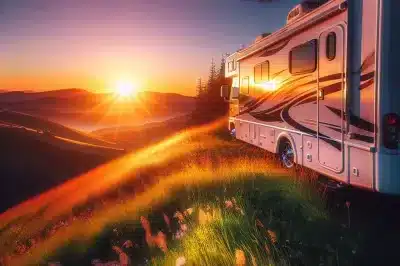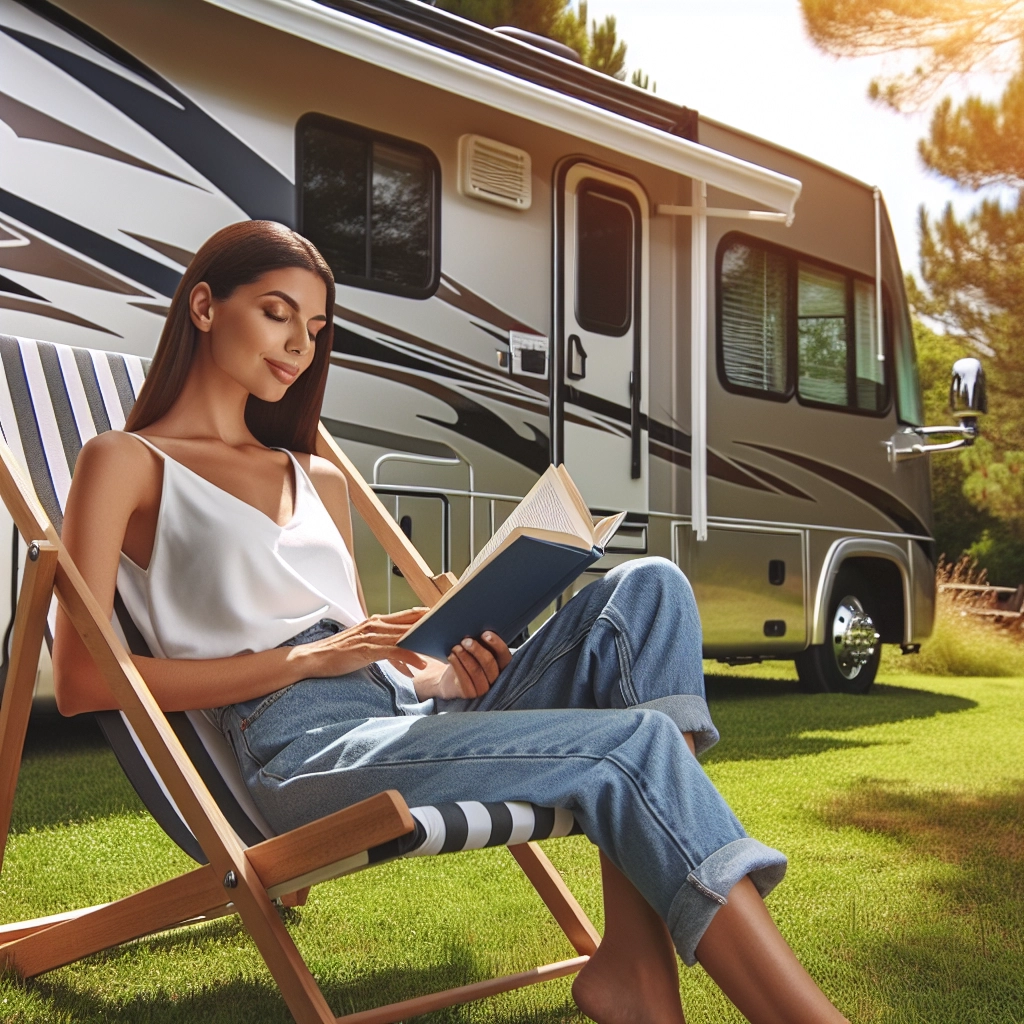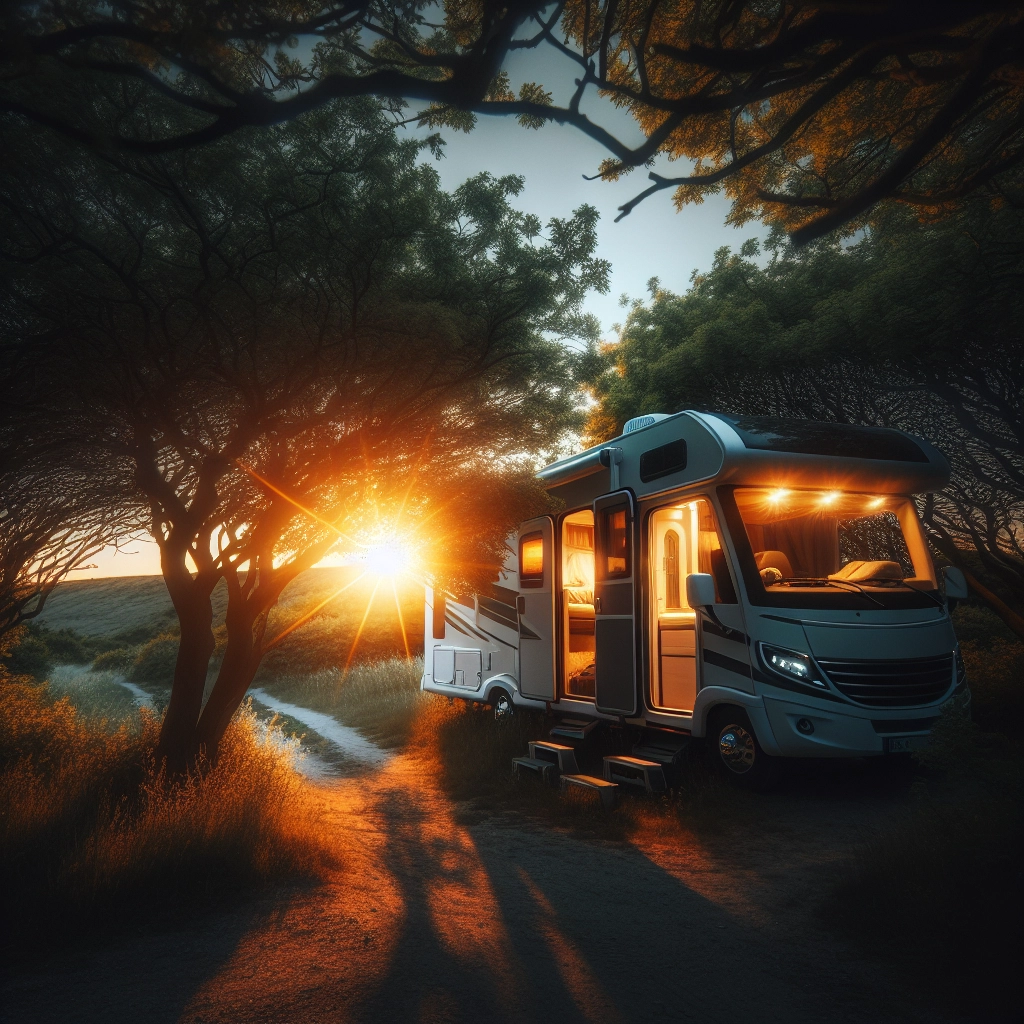Table of Contents

Empower Your Boondocking Experience with Flexible Solar Solutions
Imagine waking up to the gentle hum of nature, your RV nestled in a picturesque landscape, far from the hustle and bustle of the city. This is boondocking, a way of camping without hookups, where freedom and self-sufficiency are the order of the day. To truly embrace this lifestyle, solar power becomes your best ally, offering the independence to roam without sacrificing the comforts of home.
Key Takeaways
- Solar power is essential for the freedom of boondocking, providing energy wherever you park.
- Flexible solar panels are lightweight, durable, and perfect for the varied surfaces of an RV.
- Going solar means more than just power; it’s about embracing a sustainable and self-sufficient lifestyle.
- Understanding your energy needs is crucial to choosing the right solar setup for your RV.
- Maintaining your solar panels is simple and ensures a long-lasting, efficient energy source.
What Makes Solar Power a Must-Have for Boondocking?
When you’re boondocking, traditional power sources are out of reach, and generators can be noisy, costly, and harmful to the environment. Solar power steps in as a silent, cost-effective, and eco-friendly alternative. It gives you the ability to harness the sun’s energy, ensuring that your batteries stay charged and your adventures continue uninterrupted.
Top Benefits of Switching to Solar While Off-Grid
Switching to solar power isn’t just about keeping the lights on. It’s a game-changer for the boondocking lifestyle. Solar power reduces your carbon footprint, cuts down on generator noise, and minimizes maintenance. Plus, it can increase the resale value of your RV. Most importantly, it gives you the freedom to explore without the worry of finding the next power source.
The Basics of Boondocking and Solar Integration
Boondocking with solar power might sound complex, but it’s quite straightforward once you grasp the basics. Your RV becomes a mobile power station, equipped with solar panels, a charge controller, batteries, and an inverter. This system converts sunlight into electricity, stores it, and makes it available for use anytime, anywhere.
Understanding Boondocking and Off-Grid Living
- Boondocking is about self-sufficiency, requiring careful planning and conservation of resources.
- Off-grid living means being disconnected from municipal power, water, and sewer systems.
- Solar power allows for a comfortable off-grid experience by providing a reliable energy source.
- It’s important to assess your energy needs to determine how much solar power you’ll require.
- Choosing the right solar equipment can make all the difference in your boondocking adventures.
How Solar Panels Work in an Off-Grid Environment
Let’s break it down: solar panels convert sunlight into electricity that your RV can use. They’re made up of photovoltaic cells that create an electric current when exposed to sunlight. In an off-grid setting, this current flows to a charge controller, which regulates the charge to the batteries, preventing overcharging and damage. These batteries store the energy, making it available for use day or night, rain or shine.
Choosing Your Solar Companion: Panels and Kits for Every RV
With a variety of solar products on the market, finding the perfect fit for your RV is easier than ever. Whether you’re looking for a full kit to get started or individual panels to expand your existing setup, there’s something for every need and budget. Remember, the goal is to match your energy consumption with the right amount of solar power production.
Determining the Right Panel Size and Capacity for Your Needs
To figure out the right panel size and capacity, start by calculating your daily power usage in watt-hours. Then, consider how many hours of sunlight you typically get. With these numbers, you can determine the total wattage you’ll need from your solar panels. Keep in mind, it’s smart to add a buffer to your calculations to account for variables like weather and shading.
Comparing Flexible, Rigid, and Portable Solar Options
- Flexible solar panels are lightweight and can conform to the shape of your RV’s roof, making them ideal for uneven surfaces.
- Rigid solar panels are durable and often more cost-effective, but they require a flat surface for mounting.
- Portable solar panels allow you to chase the sun, positioning them for optimal sunlight throughout the day.
- Each type has its own set of pros and cons, so consider your RV’s characteristics and your travel habits when choosing.

Step by Step: Installing Flexible Solar Panels on Your RV
Installing flexible solar panels is a project many RV owners tackle themselves. The process involves mounting the panels, wiring them to a charge controller, and connecting everything to your batteries and inverter. It’s a straightforward task that can be completed in a day or two, depending on the size and complexity of your system.
Gathering the Tools and Materials You’ll Need
Before you start, you’ll need the right tools and materials. This typically includes the solar panels, a charge controller, mounting brackets or adhesive, wiring, connectors, and sealant. You’ll also want tools like a drill, screwdriver, wire cutters, and a caulking gun. Make sure you have everything on hand before you begin to ensure a smooth installation process.
Installation Process Overview
Installing your flexible solar panels is a task you can proudly accomplish with a bit of know-how and patience. Begin by planning your layout, ensuring there’s enough space and the panels are positioned away from potential shading. Clean the surface of your RV roof and apply the adhesive or use mounting brackets to secure the panels. Connect the panels to the charge controller, which then connects to the batteries and inverter. Finally, check all connections, secure any loose wiring, and test your system to bask in the glow of self-generated, clean energy.
Maintenance and Safety Tips for Your Solar Set-Up
Keep your solar setup in top condition with regular maintenance. Clean your panels with a soft cloth and mild detergent to ensure maximum efficiency. Check the mounting hardware and electrical connections periodically for signs of wear or corrosion. Always follow safety guidelines when working on your system—shut it down before making adjustments and be cautious when working at heights. A well-maintained solar setup not only performs better but also lasts longer, making it a reliable power source for your adventures.
Maximizing Solar Efficiency During Your Travels
Getting the most out of your solar panels means paying attention to efficiency. This involves positioning, maintenance, and understanding the sun’s path. By maximizing efficiency, you’ll generate more power, which can extend your boondocking stays and reduce the need for alternative power sources. Let’s explore how to make sure you’re getting every possible watt from your solar investment.
Positioning Panels for Optimal Sunlight Exposure
To maximize solar gain, position your panels so they face the sun for the majority of the day. If you have portable panels, move them throughout the day to follow the sun’s arc. For mounted panels, parking your RV so that the panels are oriented towards the sun can make a significant difference. Avoid parking under trees or next to tall structures that could cast shadows and reduce your solar intake.
Battery and Charge Controller Best Practices
Your batteries store the precious energy your panels harvest, so treat them well. Keep them at a healthy charge level—never fully depleted nor overcharged. The charge controller is the guardian of your battery’s health, so ensure it’s set correctly for your battery type and size. Regularly inspect connections for corrosion and ensure the controller is free from debris and well-ventilated to prevent overheating.
Adventures in Sunshine: Real Stories from Solar-Powered RVers
Meet John and Linda, a couple who transformed their RV life with solar power. They shared how, after installing flexible solar panels, they ventured into the wilds of the American Southwest, free from the worry of power availability. Their solar setup allowed them to live comfortably for weeks, enjoying the serenity of nature without the noise and fumes of a generator. It’s these real-life experiences that showcase the true potential of solar power in the world of boondocking.
How Flexible Solar Changed the Game for Long-Term Boondockers
For those who call their RV home for months at a time, flexible solar panels have been nothing short of revolutionary. Gone are the days of constant searches for RV parks to plug in for electricity. Now, long-term boondockers like Mike and Ann can park their home-on-wheels in remote, tranquil locations and still enjoy modern conveniences, all thanks to the sun’s power harnessed by their flexible solar panels. They’ve even noticed a significant decrease in their living expenses, as the sun doesn’t send a bill.
Short-Term Trips and the Impact of Solar Solutions
Even if you’re only escaping for the weekend, solar solutions can greatly enhance your experience. Take Sarah, who enjoys spontaneous getaways in her camper. With a simple solar setup, she no longer has to worry about her destination’s amenities. Her lights, fridge, and devices stay powered, and she can focus on making memories rather than managing resources. Solar power has made short-term trips more about adventure and less about logistics.

Upgrading Your RV’s Energy System with Next-Gen Technology
As technology advances, so does the opportunity to upgrade your RV’s energy system. Today’s market offers cutting-edge solutions that not only provide power but also enhance efficiency and user-friendliness. With smarter technology, managing your RV’s energy needs becomes almost as easy as using a smartphone app.
The Rise of Smart Solar Charging Systems
Smart solar charging systems are a game-changer. These systems allow you to monitor and adjust your solar power setup with ease. Imagine being able to check your energy production and consumption in real-time, or being alerted when it’s time to clean your panels for optimal performance—all from your phone or tablet. This level of control ensures that you’re always making the most of your solar investment.
Integrating Solar with Other RV Technologies
- Combining solar power with LED lighting can drastically reduce your energy consumption.
- Smart thermostats can help manage climate control, using solar power to keep your RV comfortable.
- Energy management systems can automatically switch between solar, battery, and generator power, optimizing usage.
- Wi-Fi and satellite systems powered by solar allow for connectivity even in the most remote locations.
FAQs on Boondocking with Flexible Solar Solutions
When it comes to boondocking with solar power, questions abound. Let’s address some of the most common inquiries to help you understand how solar can work for you.
What Happens to Solar Panels in Severe Weather Conditions?
Flexible solar panels are designed to be tough. They can handle high winds and heavy rain. In the event of severe weather, like hail or snowstorms, it’s best to take precautions. If possible, move portable panels to a sheltered location. For mounted panels, check that they’re securely attached and have no loose wires. After the storm, inspect your panels for any damage and clear off any debris or snow to ensure they’re operating efficiently.
Are Solar Solutions Cost-Effective for Frequent Boondocking?
For those who love the freedom of frequent boondocking, solar solutions are a smart financial move. The initial setup cost is quickly offset by the savings on campground fees and generator fuel. Plus, solar panels require little maintenance, which means more savings over time. And let’s not forget the potential increase in your RV’s resale value. In the long run, solar is a win-win for your wallet and the environment.
How Do I Maintain My Flexible Solar Panels?
Maintenance is key to longevity and performance. Keep your panels clean by wiping them with a damp cloth to remove dust, leaves, and bird droppings. Inspect the surface for scratches or damage periodically, especially after a long trip. Check the cables and connections for signs of wear or corrosion. By keeping an eye on these details, you can ensure your panels are always working at their best.
Can I Install Flexible Solar Panels Myself?
Installing flexible solar panels can be a satisfying DIY project. With the right tools, a bit of patience, and a careful read of the instructions, most RV owners can handle the job. Ensure the roof surface is clean and choose a dry day for the installation. Use the recommended adhesive or mounting hardware, connect the electrical components, and you’re set. If you’re hesitant about working with electricity, consult with a professional for the wiring part.
How Many Panels Do I Need to Power My RV?
Calculating the number of panels you need is like putting together a personalized energy puzzle. Start by listing all your electronic devices and how much power they use. Add up their consumption to find your daily watt-hour total. Then, consider the average hours of sunlight you’ll get. Divide your daily consumption by sunlight hours to get the total watts of solar panels needed. It’s wise to add a 20-25% buffer for inefficiencies and unexpected usage.
In conclusion, embracing solar power for your RV is not just about joining the green revolution—it’s about unlocking the full potential of your boondocking lifestyle. With the right setup, you can explore the great outdoors with the comforts of home, all while being kind to the planet. The journey to solar power may seem daunting at first, but with the information and tips provided, you’re now equipped to make an informed decision. So, go ahead, harness the power of the sun, and enjoy your freedom on the open road!
- Boondocking RVs: Flexible Solar Solutions – 3 March 2024
- Renewable Energy Tips for Full-Time Boondocking RVers – 2 March 2024
- Boondocking Solar Power Systems: Sizing Options & Solutions for Motorhomes – 1 March 2024
